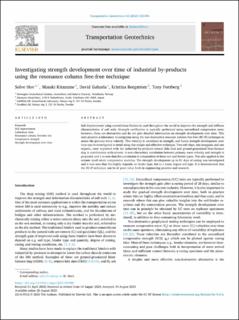| dc.contributor.author | Hov, Sølve | |
| dc.contributor.author | Kitazume, Masaki | |
| dc.contributor.author | Gaharia, David | |
| dc.contributor.author | Borgström, Kristina | |
| dc.contributor.author | Forsberg, Tony | |
| dc.date.accessioned | 2024-01-31T13:12:12Z | |
| dc.date.available | 2024-01-31T13:12:12Z | |
| dc.date.created | 2023-09-25T14:06:24Z | |
| dc.date.issued | 2023 | |
| dc.identifier.citation | Transportation Geotechnics. 2023, 42 . | en_US |
| dc.identifier.issn | 2214-3912 | |
| dc.identifier.uri | https://hdl.handle.net/11250/3114872 | |
| dc.description.abstract | Soil improvement using cementitious binders is used throughout the world to improve the strength and stiffness characteristics of soft soils. Strength verification is typically performed using unconfined compression tests; however, these are destructive and do not give detailed information on strength development over time. This note presents a laboratory investigation using the non-destructive resonant column free-free (RC-ff) technique to assess the primary wave velocity. This velocity is correlated to strength, and hence strength development over time can be investigated in detail using this simple and effective technique. Two soft clays, one inorganic and one organic, were improved with the industrial by-products cement kiln dust and ground-granulated blast-furnace slag in combination with cement. A semi-theoretical correlation between primary wave velocity and strength is proposed, and it is seen that this correlation is independent of these soil and binder types. This also applied to the seismic small-strain compressive modulus. The strength development up to 91 days of curing was investigated and it was seen that this highly depends on binder type, but to a lesser degree soil type. It is demonstrated that the RC-ff technique can be of great value both in engineering practice and research. | en_US |
| dc.language.iso | eng | en_US |
| dc.publisher | Elsevier | en_US |
| dc.rights | Attribution-NonCommercial-NoDerivatives 4.0 Internasjonal | * |
| dc.rights.uri | http://creativecommons.org/licenses/by-nc-nd/4.0/deed.no | * |
| dc.title | Investigating strength development over time of industrial by-products using the resonance column free-free technique | en_US |
| dc.title.alternative | Investigating strength development over time of industrial by-products using the resonance column free-free technique | en_US |
| dc.type | Peer reviewed | en_US |
| dc.type | Journal article | en_US |
| dc.description.version | publishedVersion | en_US |
| dc.source.pagenumber | 0 | en_US |
| dc.source.volume | 42 | en_US |
| dc.source.journal | Transportation Geotechnics | en_US |
| dc.identifier.doi | 10.1016/j.trgeo.2023.101090 | |
| dc.identifier.cristin | 2178626 | |
| cristin.ispublished | true | |
| cristin.fulltext | original | |
| cristin.qualitycode | 1 | |

